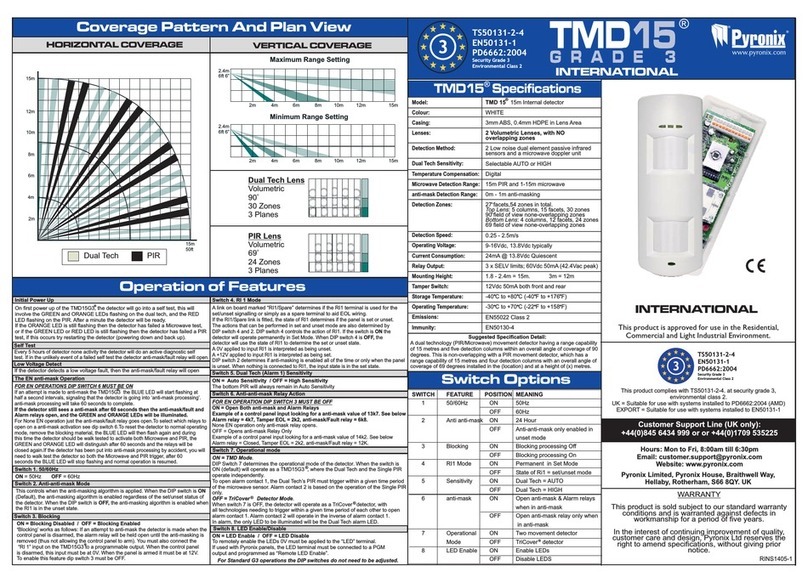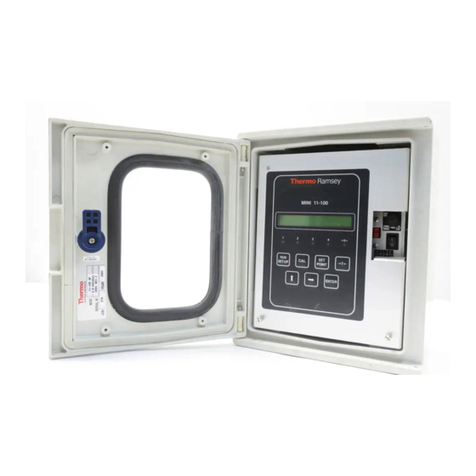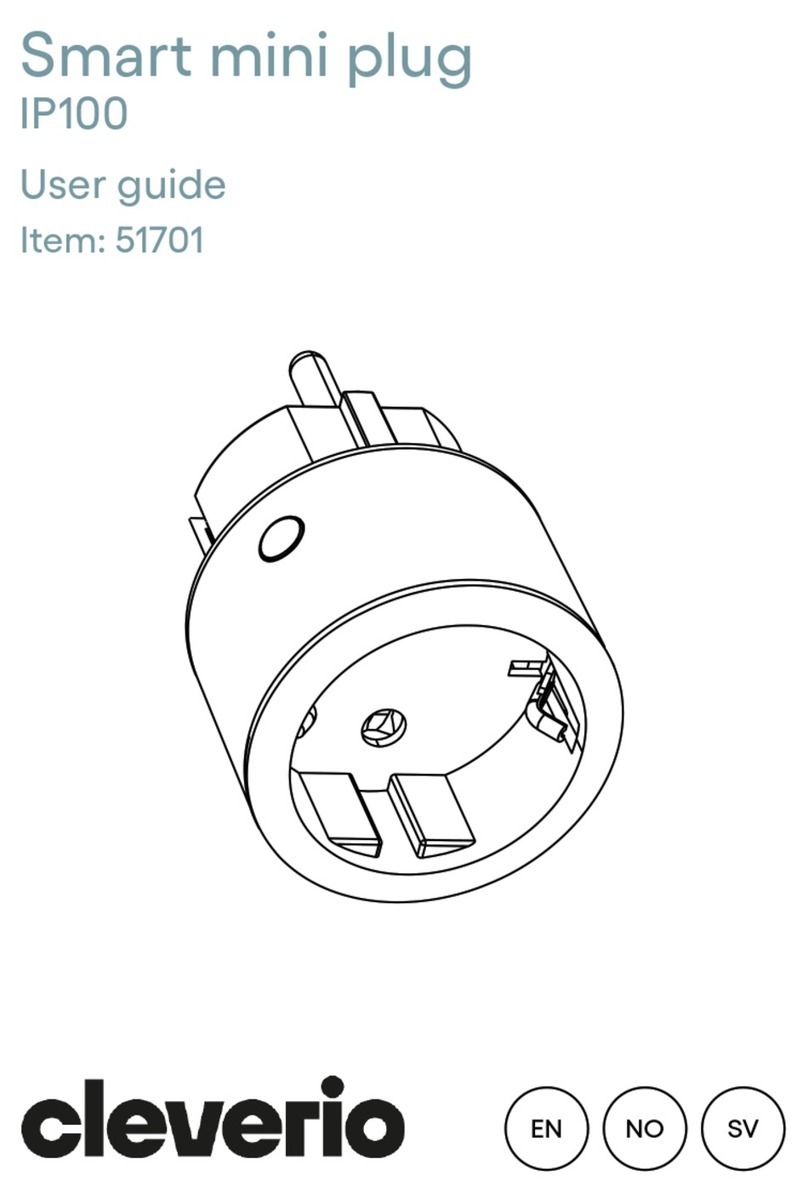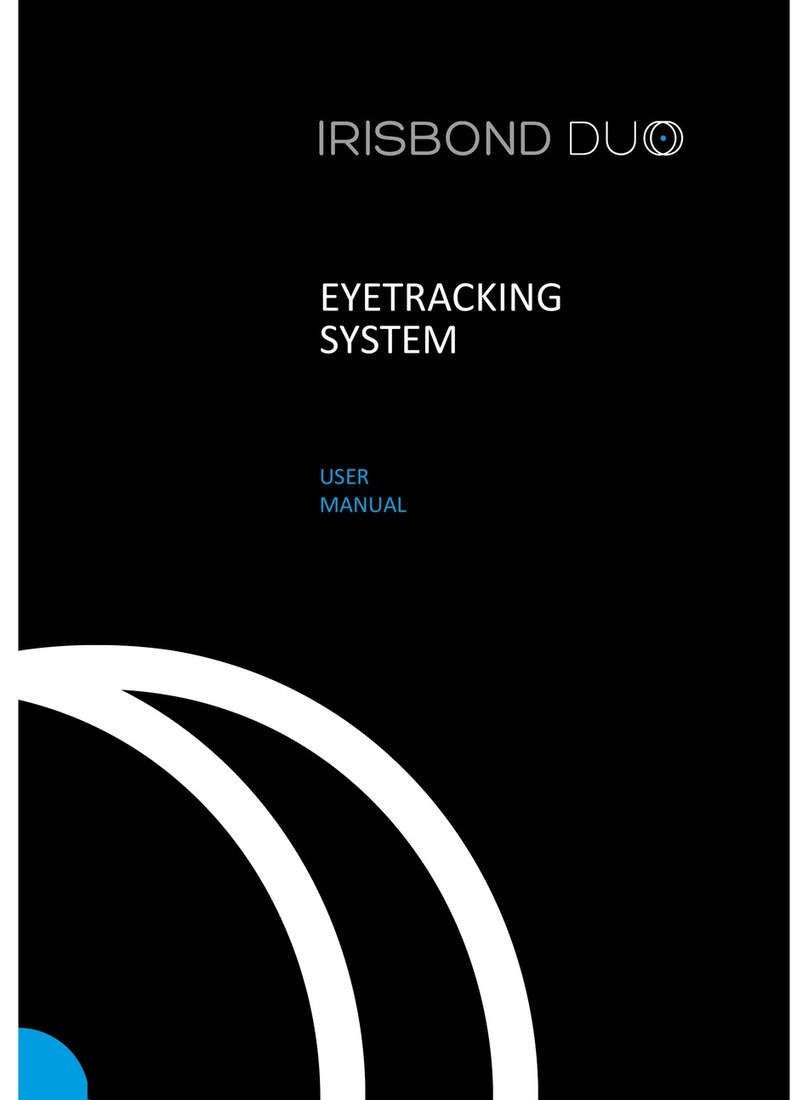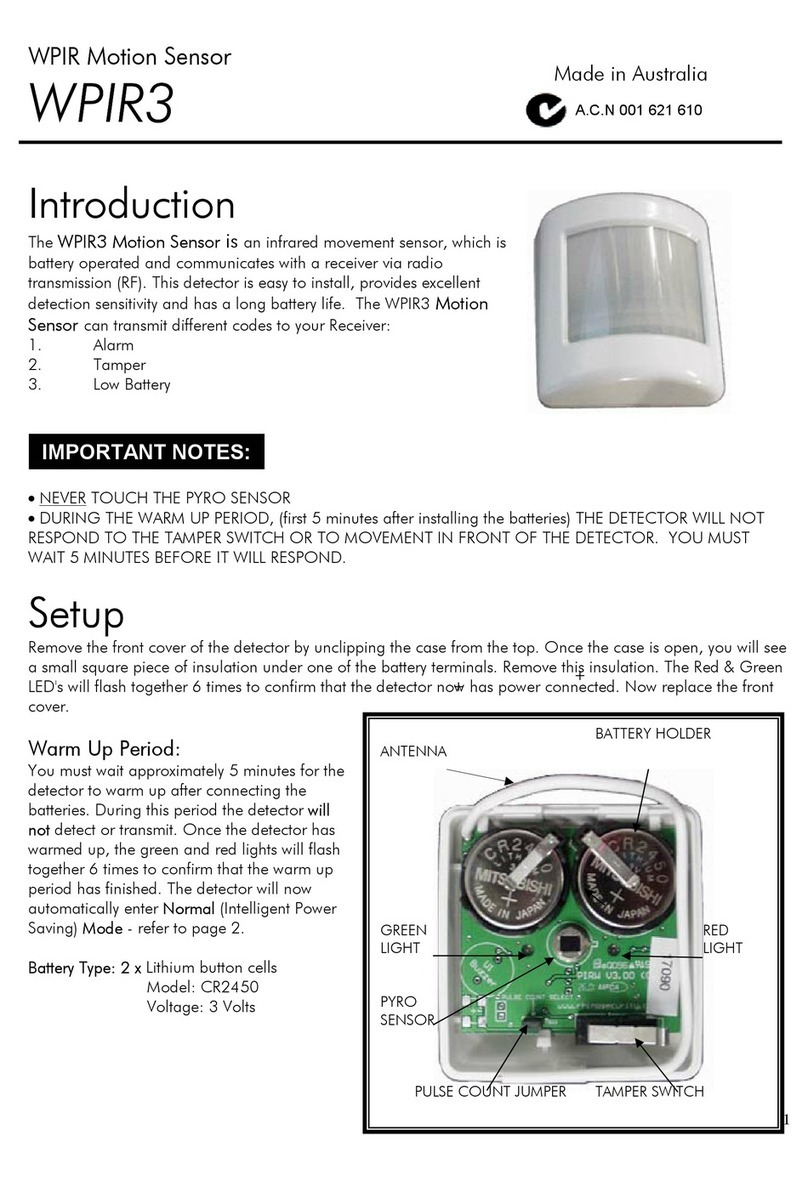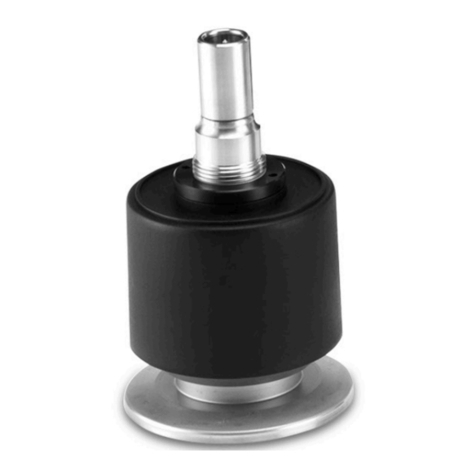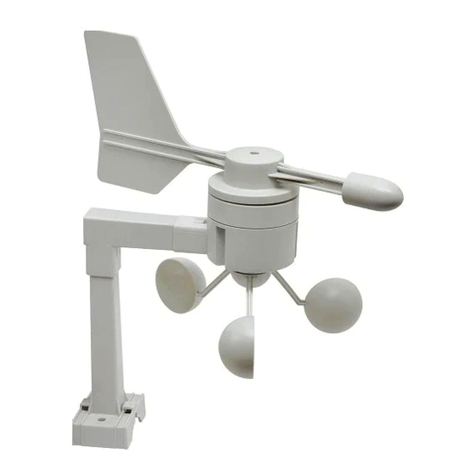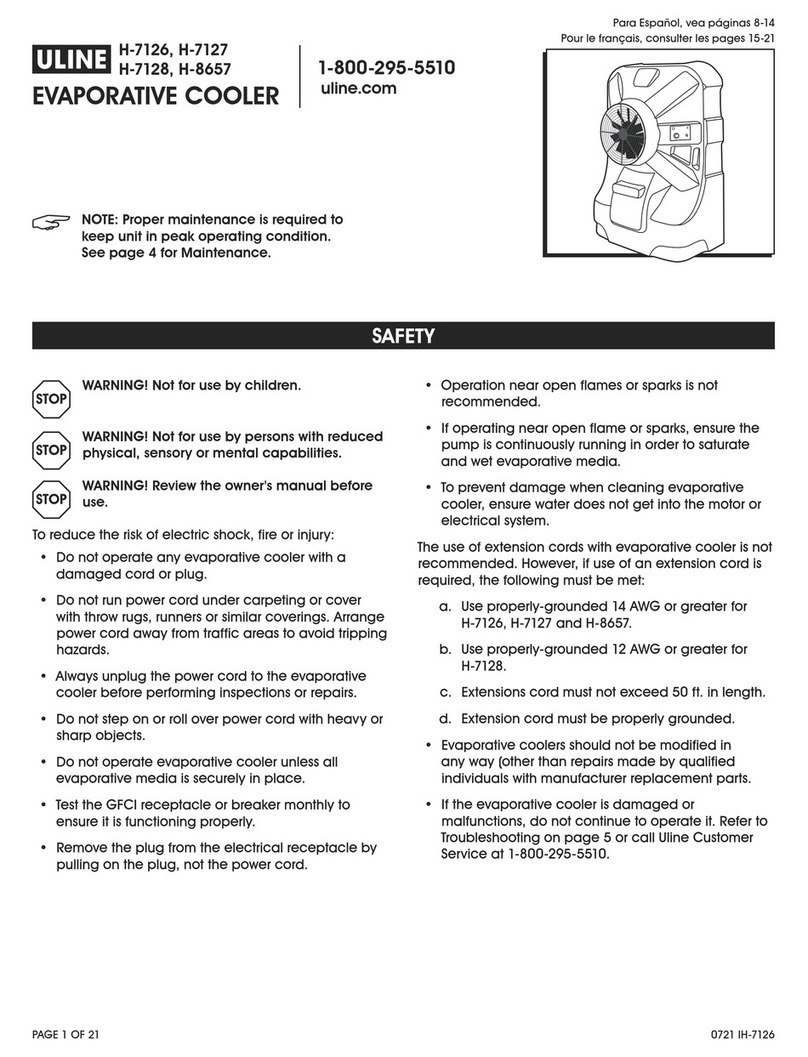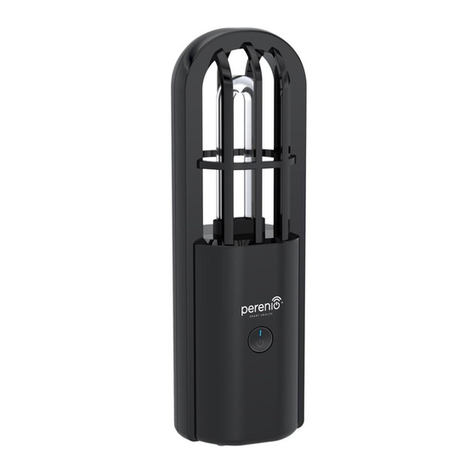Acuity AccuRange AR3000 User manual

AR3000 User’s Manual
Rev 8/25
Limited Use License Agreement
YOU SHOULD CAREFULLY READ THE FOLLOWING TERMS AND CONDITIONS BEFORE OPENING THE PACKAGE
CONTAINING THE COMPUTER SOFTWARE AND HARDWARE LICENSED HEREUNDER. CONNECTING POWER TO THE
MICROPROCESSOR CONTROL UNIT INDICATES YOUR ACCEPTANCE OF THESE TERMS AND CONDITIONS. IF YOU DO NOT
AGREE WITH THEM, YOU SHOULD PROMPTLY RETURN THE UNIT WITH POWER SEAL INTACT TO THE PERSON FROM
WHOM IT WAS PURCHASED WITHIN FIFTEEN DAYS FROM DATE OF PURCHASE AND YOUR MONEY WILL BE REFUNDED BY
THAT PERSON. IF THE PERSON FROM WHOM YOU PURCHASED THIS PRODUCT FAILS TO REFUND YOUR MONEY, CONTACT
SCHMITT INDUSTRIES INCORPORATED IMMEDIATELY AT THE ADDRESS SET OUT BELOW.
Schmitt Industries Incorporated provides the hardware and computer software program contained in the microprocessor control unit, and licenses
the use of the product to you. You assume responsibility for the selection of the product suited to achieve your intended results, and for the
installation, use and results obtained. Upon initial usage of the product your purchase price shall be considered a nonrefundable license fee unless
prior written waivers are obtained from Schmitt Industries incorporated.
LICENSE
a. You are granted a personal, nontransferable and non-exclusive license to use the hardware and software in this Agreement. Title and
ownership of the hardware and software and documentation remain in Schmitt Industries, Incorporated;
b. the hardware and software may be used by you only on a single installation;
c. you and your employees and agents are required to protect the confidentiality of the hardware and software. You may not distribute,
disclose, or otherwise make the hardware and software or documentation available to any third party;
d. you may not copy or reproduce the hardware and software or documentation for any purpose;
e. your may not assign or transfer the hardware and software or this license to any other person without the express prior written consent of
Schmitt Industries Incorporated;
f. you acknowledge that you are receiving only a LIMITED LICENSE TO USE the hardware and software and related documentation and
that Schmitt Industries Incorporated retains title to the hardware and software and documentation. You acknowledge that Schmitt Industries
Incorporated has a valuable proprietary interest in the hardware and software and documentation.
YOU MAY NOT USE, COPY, MODIFY, OR TRANSFER THE HARDWARE AND SOFTWARE, IN WHOLE OR IN ANY PART,
WITHOUT THE PRIOR WRITTEN CONSENT OF SCHMITT INDUSTRIES, INCORPORATED.
IF YOU TRANSFER POSSESSION OF ANY PORTION OF THE HARDWARE OR SOFTWARE TO ANOTHER PARTY, YOUR LICENSE
IS AUTOMATICALLY TERMINATED. TERM
The license is effective until terminated. You may terminate it at any other time by returning all hardware and software together with all copies
of associated documentation. It will also terminate upon conditions set forth elsewhere in this Agreement or if you fail to comply with any term
or condition of this Agreement. You agree upon such termination to return the hardware and software together with all copies of associated
documentation. In the event of termination the obligation of confidentiality shall survive.
12 MONTH LIMITED WARRANTY
EXCEPT AS STATED BELOW IN THIS SECTION THIS PRODUCT IS PROVIDED “AS IS” WITHOUT WARRANTY OF ANY KIND,
EITHER EXPRESSED OR IMPLIED, INCLUDING, BUT NOT LIMITED TO, THE IMPLIED WARRANTIES OF MERCHANTABILITY
AND FITNESS FOR A PARTICULAR PURPOSE.
Schmitt Industries Incorporated does not warrant that the functions contained in the product will meet your requirements or that the operation of
the product will be uninterrupted or error free.
Schmitt Industries Incorporated does warrant as the only warranty provided to you, that the product which is furnished to you, will be free from
defects in materials and workmanship under normal use for a period of twelve (12) months from the date of delivery to you as evidenced by a
copy of your warrant receipt. LIMITATIONS OF REMEDIES
Schmitt Industries Incorporated’s entire liability and your exclusive remedy shall be:
1. the replacement of any hardware and software not meeting Schmitt Industries’ “Limited Warranty” and which is returned to Schmitt
Industries Incorporated or an authorized Schmitt Industries dealer with a copy of your purchase receipt, or
2. if Schmitt Industries Incorporated or the dealer is unable within ninety (90) days to deliver a replacement product which is free of defects in
material or workmanship, you may terminate this Agreement by returning the product and your money will be refunded to you by the dealer from
whom you purchased the product.
IN NO EVENT WILL SCHMITT INDUSTRIES INCORPORATED BE LIABLE TO YOU FOR ANY DAMAGES, INCLUDING ANY LOST
PROFITS, LOST SAVINGS OR OTHER INCIDENTAL OR CONSEQUENTIAL DAMAGES ARISING OUT OF THE USE OR INABILITY
TO USE SUCH PRODUCTS EVEN IF SCHMITT INDUSTRIES INCORPORATED OR AN AUTHORIZED DEALER HAD BEEN
ADVISED OF THE POSSIBILITY OF SUCH DAMAGES, OR FOR ANY CLAIM BY ANY OTHER PARTY.
SOME AREAS DO NOT ALLOW THE LIMITATIONS OR EXCLUSION OF LIABILITY FOR INCIDENTAL OR CONSEQUENTIAL
DAMAGES SO THE ABOVE LIMITATION OR EXCLUSION MAY NOT APPLY TO YOU.
GENERAL
You may not sublicense, assign or transfer the license or the hardware, software, and documentation except as expressly provided in this
Agreement. Any attempt otherwise to sublicense, assign or transfer any of the rights, duties or obligations hereunder is void.
This Agreement will be governed by the laws of the United States and the State of Oregon, United States of America.
Should you have any questions concerning this Agreement, you may contact Schmitt Industries Incorporated by writing to:
Schmitt Industries Incorporated
2765 NW Nicolai St.
Portland, Oregon 97210 USA
YOU ACKNOWLEDGE THAT YOU HAVE READ THIS AGREEMENT, UNDERSTAND IT AND AGREE TO BE BOUND BY ITS
TERMS AND CONDITIONS. YOU FURTHER AGREE THAT IT IS THE COMPLETE AND EXCLUSIVE STATEMENT OF THE
AGREEMENT BETWEEN YOU AND SCHMITT INDUSTRIES INCORPORATED AND ITS DEALER (“US”) WHICH SUPERSEDED
ANY PROPOSAL OR PRIOR AGREEMENT, ORAL OR WRITTEN, AND ANY OTHER COMMUNICATIONS BETWEEN US RELATING
TO THE SUBJECT MATTER OF THIS AGREEMENT.

AR3000 User’s Manual i
LLL003001 –Rev 2/10
Procedures for Obtaining Warranty Service
1. Contact your Acuity distributor or call Schmitt Industries, Inc. to obtain a return
merchandise authorization (RMA) number within the applicable warranty period.
Schmitt Industries will not accept any returned product without an RMA number.
2. Ship the product to Schmitt Industries, postage prepaid, together with your bill of sale
or other proof of purchase. your name, address, description of the problem(s). Print the
RMA number you have obtained on the outside of the package.
This device has been tested for electromagnetic emissions and immunity and has
been found to be in compliance with the following directives for class B equipment:
EN 61326/A3:2003
This device complies with part 15 of the FCC Rules. Operation is subject to the
following two conditions:
(1) This device may not cause harmful interference, and (2) this device must accept
any interference received, including interference that may cause undesired
operation.
Note: This equipment has been tested and found to comply with the limits for a Class A
digital device, pursuant to part 15 of the FCC rules. These limits are designed to provide
reasonable protection against harmful interference when the equipment is operated in a
commercial environment. This equipment generates, uses, and can radiate radio
frequency energy and, if not installed and used in accordance with the instruction manual,
may cause harmful interference to radio communications. Operation of this device in a
residential area is likely to cause harmful interference in which case the user will be
required to correct the interference at his or her own expense.
This manual copyright © 2008, Schmitt Industries, Inc.

AR3000 User’s Manual ii
LLL003001 –Rev 2/10

AR3000 User’s Manual iii
LLL003001 –Rev 2/10
User’s Manual for the
AR3000™ Series Distance Measurement Sensors
Rev. 1.9
For use with AR3000
Table of Contents
1. INTRODUCTION ...............................................................................................................................................1
1.1. GENERAL OVERVIEW ..................................................................................................................................1
1.2. DEFINITION OF TERMS.................................................................................................................................2
1.3. QUICK START INSTRUCTIONS......................................................................................................................2
1.3.1. Mounting and Power connection...........................................................................................................2
1.3.2. Serial Data Wires ..................................................................................................................................3
1.3.3. Analog Output Signals...........................................................................................................................3
1.3.4. Alarm Signals.........................................................................................................................................3
2. GENERAL DESCRIPTION...............................................................................................................................4
2.1. PRINCIPLES OF OPERATION .........................................................................................................................4
2.2. MECHANICAL DIMENSIONS .........................................................................................................................4
2.3. INSTALLATION.............................................................................................................................................5
2.4. LASER SAFETY............................................................................................................................................5
2.5. PILOT LASER ...............................................................................................................................................6
2.6. LASER BEAM PROFILE.................................................................................................................................7
2.7. SENSOR MAINTENANCE...............................................................................................................................7
2.8. SENSOR SERVICE.........................................................................................................................................7
2.9. SENSOR SPECIFICATIONS.............................................................................................................................7
3. INSTALLATION AND CHECKOUT...............................................................................................................8
3.1. MOUNTING..................................................................................................................................................8
3.2. CABLING .....................................................................................................................................................8
3.2.1. Standalone Cabling................................................................................................................................9
3.2.2. Serial Connection to a Host Computer..................................................................................................9
3.3. POWER ON................................................................................................................................................10
3.3.1. Serial Communications Check.............................................................................................................10
3.3.2. Sensor Output Check ...........................................................................................................................10
4. SIGNAL AND POWER INTERFACE............................................................................................................12
4.1. SENSOR CABLE WIRE COLORS AND FUNCTIONS .......................................................................................12
4.1.1. Power Supply (Blue, Gray/Pink or Tan)..............................................................................................12
4.1.2. Shield (Clear).......................................................................................................................................13
4.1.3. Serial Communications RS232 or RS422 (Brown, White, Gray, Pink)................................................13
4.1.4. Analog Output (Yellow, Gray/Pink or Tan).........................................................................................14
4.1.5. Alarm Outputs (Red/Blue or alternate Orange, Violet).......................................................................15
4.1.6. Laser Trigger (Green) .........................................................................................................................16
5. SERIAL INTERFACE OPERATION.............................................................................................................17
5.1. SERIAL HARDWARE INTERFACE................................................................................................................17
5.1.1. Communications Protocol ...................................................................................................................17
5.1.2. Show Model Identifications (ID)..........................................................................................................18
5.1.3. Show Online Help (ID?) ......................................................................................................................18

AR3000 User’s Manual iv
Rev 1/10
5.1.4. Baud Rate (BRx) ..................................................................................................................................18
5.2. SERIAL DATA OUTPUT (SD, SF, TE).........................................................................................................19
5.2.1. Serial Data Format (SDx y).................................................................................................................19
5.2.2. Data Units Scale Factor (SFx.xxxxxx).................................................................................................20
5.2.3. Serial Output Termination Character (TEx)........................................................................................21
5.3. ERROR MESSAGES.....................................................................................................................................21
5.4. PILOT LASER CONTROL (PLX) ..................................................................................................................21
5.5. DISPLAYING,CONFIGURING AND RESETTING PARAMETERS......................................................................22
5.5.1. Displaying current settings (PA) .........................................................................................................22
5.5.2. Show Hardware Status (HW)...............................................................................................................22
5.5.3. Show Internal Temperature (TP).........................................................................................................22
5.5.4. Reset all Parameters (PR) ...................................................................................................................22
5.5.5. Perform Diagnostic Reset (DR)...........................................................................................................22
5.5.6. Auto Start (ASx)...................................................................................................................................23
ANALOG OUTPUT OPERATION (QA, SE).........................................................................................................24
5.6. ANALOG OUTPUT ZERO-POINT AND SPAN-POINT (QAX Y)........................................................................24
5.7. ERROR MODE (SE0, SE1 OR SE2).............................................................................................................24
6. ALARM OUTPUT OPERATION (Q1, Q2, SE).............................................................................................25
6.1. ALARM OUTPUT (Q1W X Y Z /Q2W X Y Z) ................................................................................................25
6.2. ERROR MODE BEHAVIOR FOR THE ALARM SWITCHES (SE0, SE1 OR SE2).................................................26
7. PERFORMANCE AND OPTIMIZATION ....................................................................................................27
7.1. MEASUREMENT MODES............................................................................................................................27
7.1.1. Perform Distance Measurement (DM) ................................................................................................27
7.1.2. Start Distance Tracking Mode (DT) (<Esc> to stop)..........................................................................27
7.1.3. Perform Velocity Measurement (VM)..................................................................................................27
7.1.4. Start Velocity Tracking Mode (VT) (<Esc> to stop) ...........................................................................28
7.2. SAMPLES AVERAGED (SAX)......................................................................................................................28
7.3. MEASUREMENT FREQUENCY (MFX) .........................................................................................................28
7.4. MEASUREMENT WINDOW (MWX Y) .........................................................................................................29
7.5. DISTANCE OFFSET (OFX.XXX)..................................................................................................................29
7.6. SET ORIGIN (SO).......................................................................................................................................29
8. EXTERNAL TRIGGER OPERATION ..........................................................................................................30
8.1. START EXTERNAL TRIGGER MODE (DF) (<ESC>TO STOP).......................................................................30
8.2. TRIGGER DELAY (TDX Y) .........................................................................................................................30
9. HARDWARE STATUS DISPLAY..................................................................................................................31
10. SERIAL COMMAND QUICK REFERENCE.........................................................................................32

AR3000 User’s Manual 1
Rev 1/10
1. Introduction
This section is a guide to getting started with the AR3000 and this manual. The AR3000 has a
number of configurable parameters, a minimum of which must be set before the sensor can be used
the first time. However, once the parameters are set, the sensor will default to that configuration until
changed by the user.
The recommended order for reading the manual is:
•General Overview –Gives a brief understanding of the sensor operation.
•Operating Guidelines –Provides a few important safety tips.
•Definition of Terms –An aid for proper communication.
•Quick Start Instructions –This should provide the information necessary to connect the
sensor and verify its operation, either with a serial terminal program at 9600 baud, or by
connecting the current loop or Alarm Output interface.
•General Description –Gives important laser, operation, mechanical, and mounting
information.
•Installation and Checkout –Tailor the application. Use the other chapters for reference:
Signal and Power Interface –how to hook everything up
Serial Interface Operation –modes and formats
Analog Output Operation –current loop scaling
Alarm Output Operation –alarm switch settings
Trigger Input Operation –external trigger
Performance Optimization –Sample Rate, Background Elimination, Exposure control
AR3000 Command Set –explains all commands for customizing the application
1.1. General Overview
The AR3000 is a pulsed time-of-flight rangefinder that measures distance using a laser beam, a
photodiode, and a microprocessor. The rangefinder works based on time of flight measurement
by emitting high-frequency pulsed laser light which is diffusely reflected back from the target.
This return signal is compared with a reference clock. From the amount of time, a resulting
distance is determined with great accuracy. The maximum range measurement for the device is
~10,000 feet (3000 m) using special reflective targets such as 3M 3000X reflective sheeting. On
normal diffuse surfaces, the maximum range is 980 feet (300 m). The Class 2 visible pilot laser
makes it simple to aim the rangefinder which uses a Class 1 infrared (invisible) diode. Speed and
accuracy performance vary depending on target surface reflectance. The AR3000 technical data
sheet specifies sensor performance standards.
A variety of configuration settings can be selected via the serial port. The complete list of
settings is found in the AR3000 Command Set chapter and each setting is discussed in detail in a
specific operation chapter.
The Sample Rate can be specified and the sensor has maximum capability of 2000 samples per
second. Sampling may be turned on and off. It can even be triggered using an input signal wire or
a serial command.
Measurement output is in the form of serial data (RS232 or RS422 models) and analog output (4-
20mA current loop). Special order sensors include Profibus®, or SSI interfaces. Those interface
configurations are not discussed in this manual. Contact Acuity for details.

AR3000 User’s Manual 2
Rev 1/10
Do not point the pilot laser at any person, particularly a person’s eyes or face.
Do not attempt to disassemble the sensor. Improper disassembly will destroy the optical
alignment of the sensor and necessitate factory repairs.
Do not operate the sensor in areas where the sensor case is exposed to direct sunlight for
extended periods or where the air temperature is more than 60C (140F) or less than -40°C
(-40°F).
Avoid excessive vibration and shocks. The sensor contains securely mounted but precisely
aligned optical components.
Do not scratch the lenses on the front face of the sensor. Keep the lenses clean with expert
optical procedures. The lenses are glass with an anti-reflection coating. Avoid the use of organic
cleaning solvents.
Do not touch the lenses with bare fingers. The oils are very difficult to remove.
Operate only with DC supply voltages up to 30 volts.
1.2. Definition of Terms
Sensor –The complete AR3000 measurement device.
Target –The object of measurement. The relative distance from the sensor to the target is
measured by the sensor.
Laser, Laser beam –This light (infrared measurement laser or visible pilot laser) is emitted from
the sensor, reflected from the target, and collected by the camera lens.
<Range> –The maximum relative distance measurable by the sensor.
Range –1. <Range>, 2. The region over which the target can be measured. At the near end of the
range the sensor measures zero. At the far end of the range the sensor measures its
maximum value (its Range value).
1.3. Quick Start Instructions
This will get the sensor running in its factory default configuration after selecting a measurement
mode. For full instructions use the individual sections of this manual for mounting, power
connections, data connections and configuration.
Only one output type (Serial or Analog) is needed to indicate sensor operation.
1.3.1. Mounting and Power connection
Mount the sensor in such a way that the case is not twisted or warped. Use three screws
through M4 X 6 threaded mounting holes on the sides or bottom of the AR3000 sensor. The
laser should be aimed at a target such that the distance from the sensor face to the target can
be measured.
Attach the cable’s 12-pin connector to the plug on the rear of the sensor while the power is
off.
Connect the Supply + (Blue) and Ground (Gray/Pink or alternate Tan in some cables) wires
of the sensor cable to a 10 to 30 volt DC power supply (or use the sensor’s power supply if it
came with one).

AR3000 User’s Manual 3
Rev 1/10
1.3.2. Serial Data Wires
Quick suggestion: Connect the wires to a 9 pin D-SUB male connector that can be plugged
into a COM port of a PC (RS232): Black (Ground) to pin 5, White (Transmit) to pin 2, and
Brown (Receive) to pin 3. Start a HyperTerminal program on the PC and set it for that COM
port at 115200 baud, 8 bit, 1 start, parity: none, 1 stop, no flow control.
To view distance measurements and verify functionality, type DT<Enter>. The sensor will
report its present measurements 100 times per second in millimeters. If a target surface is
placed in the measurement range of the sensor, the screen should display distance
information. The distance is measured from the start of the measurement range. If there is no
target in the measurement range, the sensor will output an error code. Note: This command
mode can only be stopped by sending an escape (<Esc>) character.
1.3.3. Analog Output Signals
Quick suggestion: connect a DVM (digital volt meter) to the wires: Gray/Pink or alternate
Tan to Common, Yellow to mA input.
The default mode is 4-20mA current loop. The meter should read near 4 mA when a target is
placed in the laser beam near 1 m range and 20 mA near 300 m range.
1.3.4. Alarm Signals
Use the Status display on the rear of the AR3000 sensor to view the activity of the Q1 and Q2
alarms.

AR3000 User’s Manual 4
Rev 1/10
2. General Description
The AR3000 is a laser diode based distance measurement sensor for ranges up to 980 feet (300m) on
regular surfaces and up to 9800 feet (3000 m) using a reflective target. The accuracy is generally
specified with a linearity of +/- 0.8 inches (20mm) at 100 Hz. Linearity will vary depending on pulse
frequency, distance averaging, temperature and surface reflectivity of the target surface.
Two versions of the AR3000 are available. The standard model (with a 2 mrad laser divergence) and
a 10 mrad model. See the data sheet for performance details.
2.1. Principles of Operation
The AR3000 uses the time of flight of light to measure distance. The laser beam is projected from
the housing’s smaller lens (top) and shines on a target surface, where it creates a spot. From the
target, the laser light is scattered in all directions. The sensor’s larger lens collects a portion of the
reflected light, which is focused on a photo detector and converted to an electrical signal which is
used to determine a distance.
2.2. Mechanical Dimensions
The following diagram shows the mechanical dimensions for the AR3000. The sensor has three
M4 X 6 threaded holes on each side and on the bottom surface for mounting to a fixture. The
cable is for power and all communication (serial, analog, trigger, power, etc.). It has a 12-pin
M16 flange-mount plug (Binder series 723). The outer case of the sensor is extruded aluminum
with powder-coated paint for corrosion resistance.
Figure 1 Mechanical layout of AR3000 sensor

AR3000 User’s Manual 5
Rev 1/10
2.3. Installation
The AR3000 sensor is typically installed by affixing the sensor to a machined bracket with
threaded bolts through the three mounting holes on either of the sensor’s sides or the bottom.
Their location is shown in the mechanical drawing of Figure 1. The laser should be aimed at a
target such that the distance from the sensor face to the target can be meausured.
2.4. Laser Safety
The AR3000 has two lasers, a measurement laser and an aiming Pilot laser. The laser used for
measurements is a Class 1 laser device in accordance with EN60825-1:2001. Laser radiation
emitted by Class 1 lasers is entirely harmless to the human eye and no precautions are necessary.
The laser used for the aiming Pilot laser is Class 2. This laser device should not be aimed at the
human eye. Installers of laser sensors should follow precautions set forth by ANSI Z136.1
Standard for the Safe Use of Lasers or by their local safety oversight organization. In the event of
accidental, short time laser exposure, the human eye is sufficiently protected by its own aversion
response (blinking). This natural reflex may be impaired by medication, alcohol and drugs.
Although the product can be operated without taking special safety precautions, refrain from
directly looking into the laser beam. Do not direct the laser beam at other people to avoid
potential eye hazards.
2 mrad 10 mrad
Figure 2 Laser safety labels for AR3000
The laser safety classification reflects worst case situations. User settings or maintenance cannot
increase the level of laser radiation. Do not attempt to loosen any screws or open the sensor
housing.

AR3000 User’s Manual 6
Rev 1/10
2.5. Pilot Laser
The Class 2 visible pilot laser is emitted from a small window between the two large lenses on the
front of the AR3000 distance measurement sensor. Its purpose is to help users aim and align the
sensor to a distant target. In the factory default startup mode, the pilot laser is enabled and flashes
at a frequency of 2 Hz.
Figure 3 - Location of Pilot Laser on front face of AR3000
The pilot laser is not aligned to emit in a direction parallel with the measurement laser. Instead,
its beam intersects with that of the measurement laser at a distance of 246 feet (75 m). The pilot
laser axis makes a 0.002° angle with the horizon. The figure below shows the tolerance on pilot
laser positioning in relation to the invisible measurement laser as a function of the distance to an
object being measured. The rectangular shape is the relative size of the infrared measurement
laser. The red-dashed circle is the perimeter inside which the pilot laser could appear. The pilot
laser is much smaller than the tolerance circle
Figure 4 Tolerance of 2 mrad Pilot Laser location relative to the infrared measurement laser
Measurement
Laser Spot Size (IR)
Location Tolerance
of pilot laser (visible)
Pilot location tolerance
at 10 meters
Pilot location tolerance
at 75 meters
Pilot location tolerance
at 125 meters

AR3000 User’s Manual 7
Rev 1/10
Figure 5 Tolerance of 10 mrad Pilot Laser location relative to the infrared measurement laser
2.6. Laser Beam Profile
The invisible measurement laser beam emitted from AR3000 sensor has a rectangular profile that
expands (diverges) as its distance from the sensor increases. This table indicates the approximate
beam dimensions at different distances from the sensor.
Distance from sensor
(meters[feet])
Laser spot height x width (mm[in])
Standard 2 mrad Sensor
10 mrad sensor
1[3]
25x53[1.0x2.1]
9x14[0.35x0.55]
10[33]
40x54[1.6x2.1]
14x104[0.55x4.1]
50[160]
106x57[4.2x2.2]
34x504[1.3x20]
100[330]
190x61[7.5x2.4]
59x1004[2.3x40]
500[1600]
856x95[34x3.7]
259x5004[10x200]
1000[3300]
1690x137[67x5.4]
509x10000[20x390]
Note that the specified divergence (2 mrad or 10 mrad) is for the faster expanding laser axis and
that the height expands faster on the 2 mrad model while the width expands faster on the 10 mrad
model.
2.7. Sensor Maintenance
The AR3000 sensor requires little maintenance from the user. The sensor lenses should be kept
clean of dust buildup as a part of regular preventative maintenance. Use compressed air to blow
dirt off the window or use delicate tissue wipes. Do not use any organic cleaning solvents on the
sensor. If a sensor does not function according to specifications, contact Schmitt Industries, Inc.
Do not attempt to loosen any screws or open the sensor housing.
2.8. Sensor Service
The AR3000 sensor has no user-serviceable parts. Refer all service questions to Schmitt
Industries, Inc. Do not attempt to loosen any screws or open the sensor housing.
2.9. Sensor Specifications
Go to http://www.acuitylaser.com/pdf/ar3000-data-sheet.pdf
at 1 m
at 5 m
at 10 m
at 25 m
at 50 m

AR3000 User’s Manual 8
Rev 1/10
3. Installation and Checkout
3.1. Mounting
Mount the sensor in such a way that the case is not twisted or warped. Using three hard points
along the front and back edges or a slightly compliant mounting system are the best methods. Do
not clamp or squeeze the sensor case excessively. If the case is distorted, the sensitivity and
accuracy of the sensor may be affected. Note that the sensor’s Zero Point is the same as the plane
created by the front-most cover plate around the lenses.
3.2. Cabling
The AR3000 has a multipurpose cable with solder tail wires. The standard cable, Schmitt p/n
CBA300201, is 6.6 feet (2 m). Longer cable lengths are available. Connection and termination
according to the instructions is essential for correct sensor operation. Read the wire descriptions
in Section 4.1 for connection information.
Connect the cable’s 12-pin connector (Binder series 425) to the sensor’s plug (Binder series 723,
M16 size) on the back cover of the AR3000 sensor. Be sure to tightly secure the connection.
Figure 6 Back cover with 12-pin plug and pin arrangement
Figure 7 Interface cable

AR3000 User’s Manual 9
Rev 1/10
3.2.1. Standalone Cabling
To use the AR3000 without a serial connection to a host computer, the only connections
necessary are the power and ground wires, the analog output wires, and optionally the alarm
output wires connecting to data display, recording, or control equipment. See Signal and
Power Interface (section 4) for wire connections. This method assumes that the sensor has
been previously configured using the serial interface to designate startup parameters and
settings.
In 4-20mA analog output mode, the best accuracy and linearity for the current loop is
obtained with a 500-ohm load to current loop return at the measurement point. The alarm
outputs can be used to indicate the analog output validity.
The two alarm output wires can be used to connect to control equipment. These signals can
also indicate the sensor’s measurement validity.
3.2.2. Serial Connection to a Host Computer
Connect a 15 or 24 volt power supply to the power and ground lines of the sensor cable. See
Signal and Power Interface (section 4) for wire connections. Only the power and ground need
to be connected for operation in addition to the serial interface. For testing use a terminal
emulation program such as the Windows® HyperTerminal. HyperTerminal is included in
most versions of Microsoft Windows. To access HyperTerminal, follow these links:
START > PROGRAMS > ACCESSORIES > COMMUNICATIONS > HYPERTERMINAL
After naming the connection and choosing an icon, choose the COM port that the AR3000 is
connected to. In the next configuration screen, set to 115200 baud, 8 bits, no parity, 1 stop
bit and no flow control to communicate with a sensor in the default configuration. Free
demonstration software is also available through the Acuity website.
RS232 model: A 9-pin serial D-sub serial female connector can be attached to the serial
output wires to connect the AR3000 directly to an IBM-PC compatible 9-pin serial port.
Figure 8- Wiring configuration for 9-pin connector for RS232 serial communications
white
brown
green
yellow
grey
pink
blue
red
black
violet
grey/pink (tan)
red/blue (orange)

AR3000 User’s Manual 10
Rev 1/10
RS422 model: An RS422 adapter must be used to connect the AR3000 to an IBM-PC
compatible computer. The RS422 wires are as follows:
Figure 9- Wiring configuration for RS422 serial communications
3.3. Power On
Caution: be sure that the laser will not cause an eye hazard.
When power is applied the red pilot laser beam will be emitted from the front of the AR3000 and
blink with a frequency of 2 Hz (default mode). The terminal emulator will show the sensor’s
firmware revision and serial number. The sensor will not transmit measurement readings until a
measurement mode is selected (see section 7.1 for more details). To begin measuring in Distance
Tracking mode, type DT<Enter>. Distance readings will scroll up the HyperTerminal window
and the units will be in meters. Note: This command mode can only be stopped by sending an
escape (<Esc>) character.
3.3.1. Serial Communications Check
If no information is received over the serial port, check the power supply and serial wire
connections. The sensor may be in a configuration that prevents serial communication, such
as being set at the wrong baud rate.
Type PR<Enter> to reset the sensor to the factory defaults (excluding the baud rate). If the
sensor’s baud rate is unknown, then the BR115200<Enter> command must be issued from
the HyperTerminal program while set at each of the AR3000’s possible baud rates until the
AR3000 accepts the command and sets the baud rate to 115200. 115200 is the standard baud
rate for the AR3000. The possible baud rates are 9600, 19200, 38400, 57600, 115200,
230400, and 460800.
3.3.2. Sensor Output Check
If the sensor output value is in error, check that the sensor and target are stationary and stable,
that the target is at least 20 inches (0.5 m) from the sensor’s zero point, and that the laser
beam is hitting the target. If ERROR codes are transmitted, perform the correction for that
ERROR code (see section 5.3).
white
brown
green
yellow
grey
pink
blue
red
black
violet
grey/pink (tan)
red/blue (orange)

AR3000 User’s Manual 11
Rev 1/10
Verify that the target is of sufficient reflectance by verifying that the “TARGET” LED on the
rear of the sensor is Yellow or Green. Do not use retro reflective targets if the “TARGET”
LED becomes RED in color when the sensor is aimed at the target.
Distance offset settings may alter the values output by the sensor. Reset the sensor to the
factory default to remove their effect (PR command).
The sensor may need to warm up for 5-10 minutes before reaching full accuracy. Leave it on
for a few minutes and re-check the sensor accuracy.

AR3000 User’s Manual 12
Rev 1/10
4. Signal and Power Interface
The AR3000 has a multipurpose cable (sensor cable) with solder tail wires. Connection and
termination according to the instructions is essential for correct sensor operation. Read the wire
descriptions for connection information.
Figure 10 AR3000 multipurpose cable with 12 conductors plus shield and corresponding pin arrangements
4.1. Sensor Cable Wire Colors and Functions
The tables below shows the wiring on systems ordered without power supplies.
Wire Color (alternate)
Pin
Function in All Modes
Green
C
External Trigger Input (3V to 30 V)
Yellow
D
Analog output (4-20 mA current loop)
Blue
G
Supply Voltage +24V (10- 30 VDC)
Red/Blue (Orange)
M
Alarm Output 1 (Q1)
Violet
K
Alarm Output 2 (Q2)
Black
J
Ground (serial)
Gray/Pink (Tan)
L
Ground (Power supply common return)
Clear
Shield
Red
H
Not connected
Table 1 Non-Serial Wire Connections
The serial communications wires can be used for either the RS232 or RS422 model. The RS422
model has a 120 ohm terminating resistor between the receiving pair’s wires (RX+ and RX-).
Function in Selected Serial Mode
Wire
Pin
RS232 models
RS422 models
Brown
B
RxD –Receive Data
RX–: Receive Data –
White
A
TxD –Transmit Data
RX+ : Receive Data +
Gray
E
Not connected
TX- : Transmit Data -
Pink
F
Not connected
TX+ : Transmit Data +
Table 2 Serial Wire Connections
4.1.1. Power Supply (Blue, Gray/Pink or Tan)
The Gray/Pink wire (or alternate Tan in some cables) is the Power Supply Common return,
also named Ground. It carries the return current for the power supply and the analog signals.

AR3000 User’s Manual 13
Rev 1/10
The Blue wire is the Power Supply Input to the sensor. The sensor requires +24 VDC power
and consumes <5 W without the heater and 11.5 W when the automatic heater is on.
Power supplies from 10 VDC to 30 VDC may be used. Higher voltages will result in
excessive current drawn by the over-voltage protection circuitry and may cause permanent
damage. 24 VDC should be used when the heater may be needed. Voltages less than 10 VDC
may result in inaccurate measurement readings or the AR3000 not even turning on.
4.1.2. Shield (Clear)
The un-insulated wire is the cable and case shield and is connected to ground inside the
sensor. It should also be connected to ground at the power supply end of the cable.
4.1.3. Serial Communications RS232 or RS422 (Brown, White, Gray, Pink)
Both the RS232 and RS422 models are compatible with the associated ANSI communication
standards. The desired model (RS232 or RS422) must be selected when ordering the
AR3000.
See Serial Interface Operation (section 5) for information on commands and data.
RS232 model: RS232 is normally used for slower speeds and shorter distances of
communications. A standard 9-pin D-SUB RS232 serial female connector can be built to
interface with an IBM or compatible computer using connection the pins below.
Color
Pin
White
2
Transmit data from sensor
Brown
3
Receive data to sensor
Black
5
Signal ground reference
n/c
1, 4, 6
DCD, DTE, DCE –These three signals can be tied together to satisfy
some PC signal requirements for hardware handshake.
n/c
7, 8
CTS, RTS –These two signals can be tied together to satisfy some PC
signal requirements for hardware handshake.
Table 3 RS232 Model Serial Connections
RS422 model: RS422 is normally used for faster speeds and longer distances of
communications. Two wires, usually twisted together, carry each differential (noise-immune)
signal. There are no standard PC connections. A special adapter is required to connect to a PC
to an RS422 model.
Color
White
Receive data to sensor (+)
Brown
Receive data to sensor (-)
Pink
Transmit data from sensor (+)
Gray
Transmit data from sensor (-)
Black
Signal ground reference
Table 4 RS422 Model Serial Connections

AR3000 User’s Manual 14
Rev 1/10
4.1.4. Analog Output (Yellow, Gray/Pink or Tan)
The Gray/Pink wire (or alternate Tan in some cables) is the return signal for the Analog
Output. It is also the power supply ground. The analog signal for distance is a 4-20 mA
current loop. Sensor error signaling can be configured to output either 3 mA or 21 mA.
In Current Loop mode the Yellow wire delivers a current proportional to the measured
distance.
Figure 11 Wiring Diagram for Analog output
The best conversion to voltage is obtained by connecting a 500-ohm load resistor (1/4 Watt
minimum) between the Yellow and Gray/Pink (alternate Tan) wires at the measurement
point. This gives a 2 volt to 10 volt output range.
See Analog Output Operation (section 5.6) for mode selection and scaling options. This will
pass the signal at full speed (2000 samples per second). To filter better at slower speeds, use a
0.047 uF capacitor (200 samples per second) or a 0.47 uF capacitor (20 samples per second).
Figure 12 Wiring Diagram for Analog output with filter
white
brown
green
yellow
grey
pink
blue
red
black
violet
grey/pink (tan)
red/blue (orange)
Table of contents
Other Acuity Accessories manuals
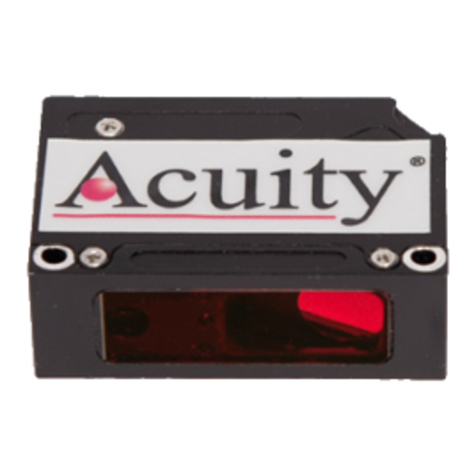
Acuity
Acuity AR100 Super Compact Laser Sensor User manual
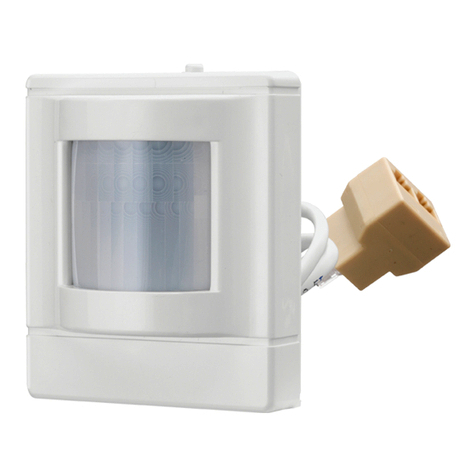
Acuity
Acuity nLight nES 7 Installation manual
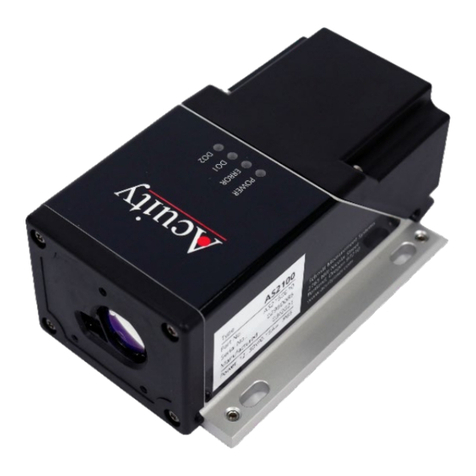
Acuity
Acuity AS2100 User manual
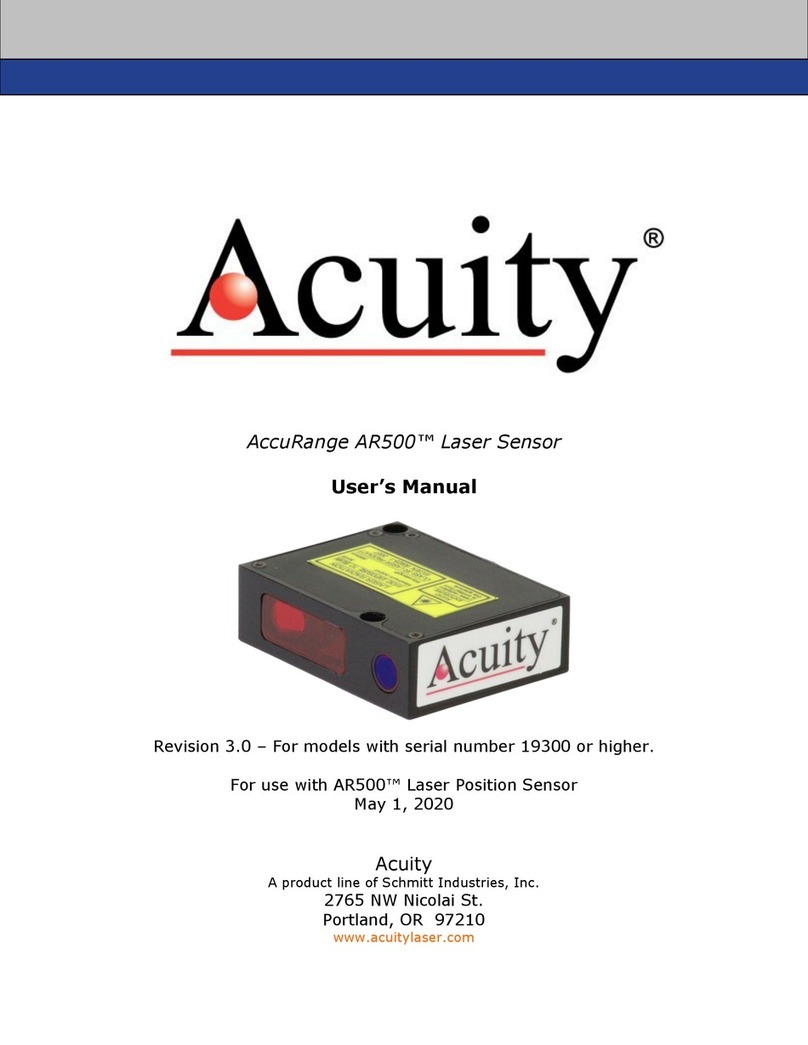
Acuity
Acuity AccuRange AR500 User manual
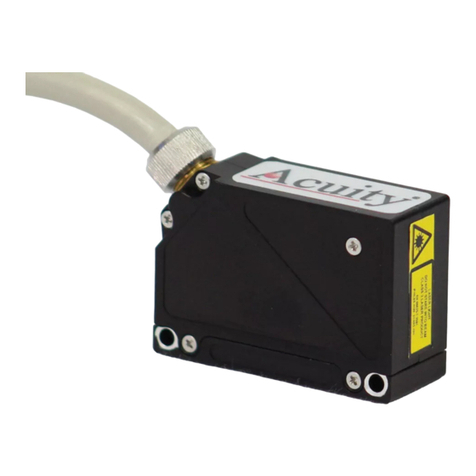
Acuity
Acuity AR100 Series User manual
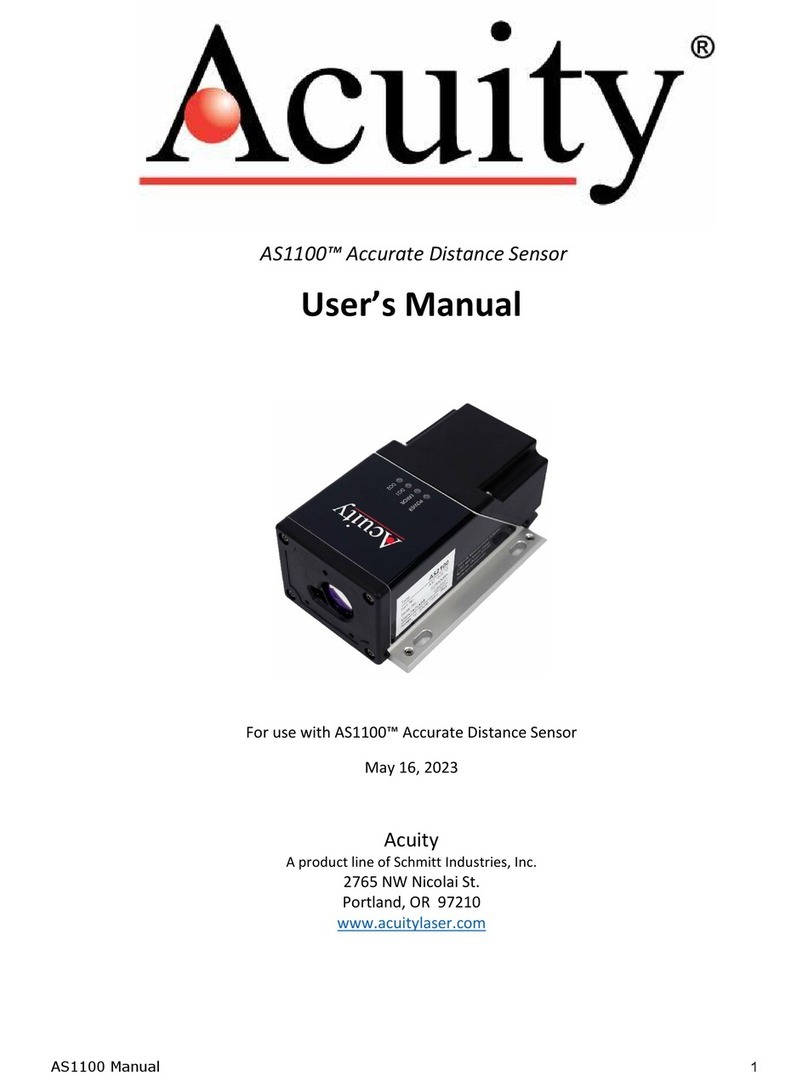
Acuity
Acuity AS1100 User manual

Acuity
Acuity AS2100 User manual
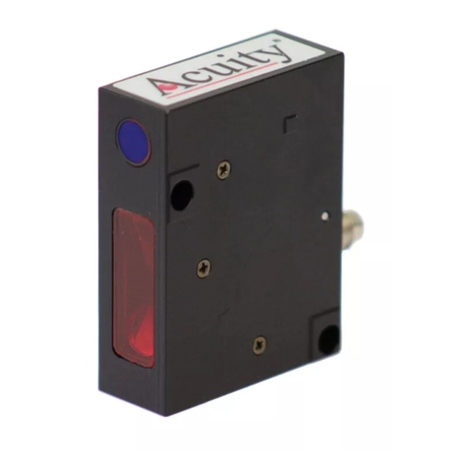
Acuity
Acuity AccuRange AR500 User manual
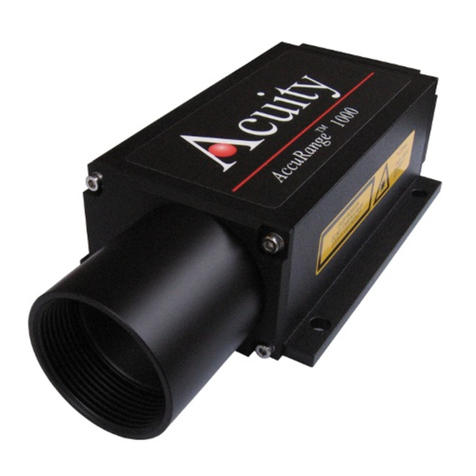
Acuity
Acuity AccuRange AR1000 User manual
Popular Accessories manuals by other brands
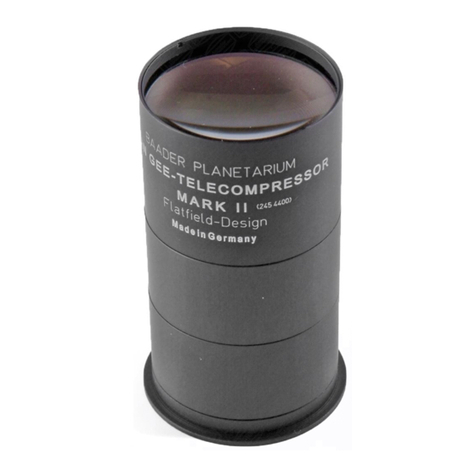
Baader Planetarium
Baader Planetarium Alan Gee II manual
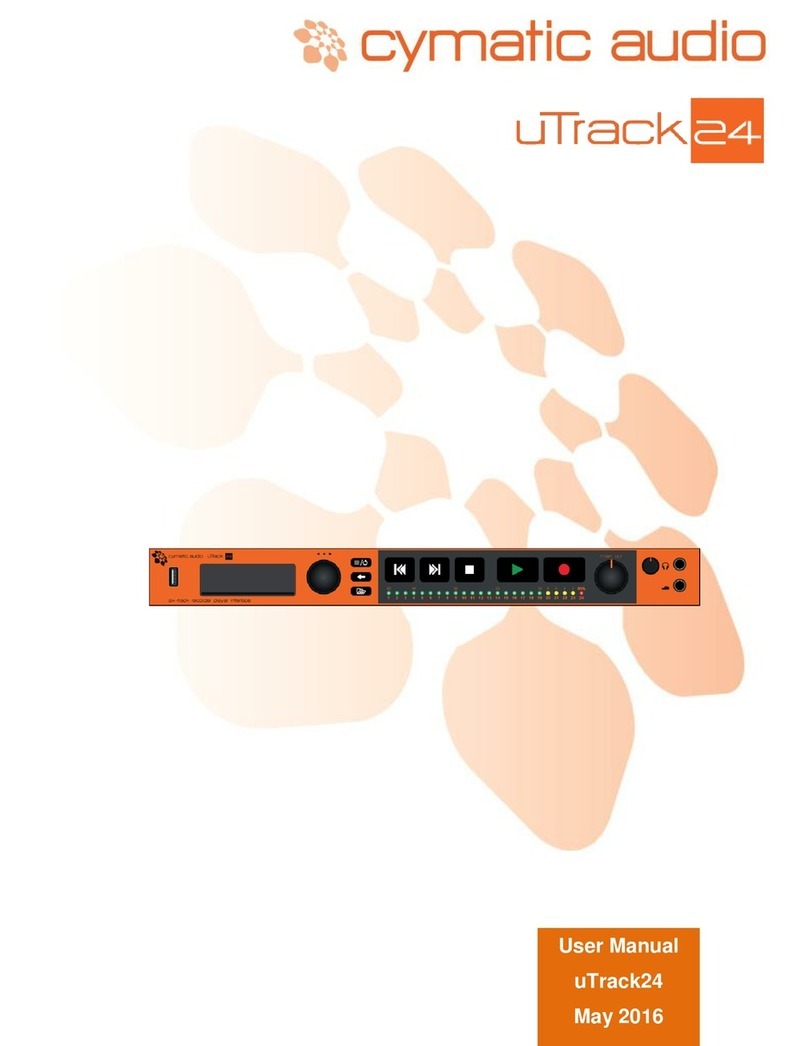
cymatic audio
cymatic audio uTrack24 audiolan user manual
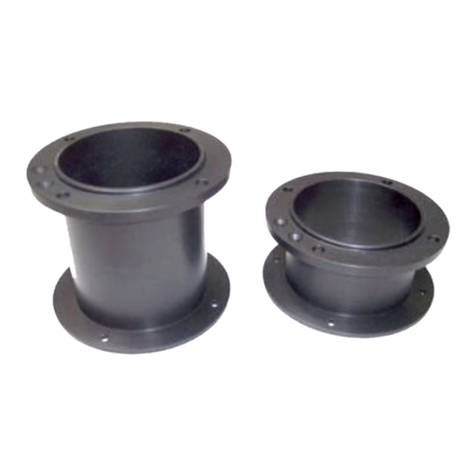
PlaneWave Instruments
PlaneWave Instruments Secure fit CCD Spacer 3.8 Installation

PCE Instruments
PCE Instruments PCE-VS11 instruction manual

Philips
Philips CRP144 brochure

Cuisinart
Cuisinart CEK-30 Instruction booklet



